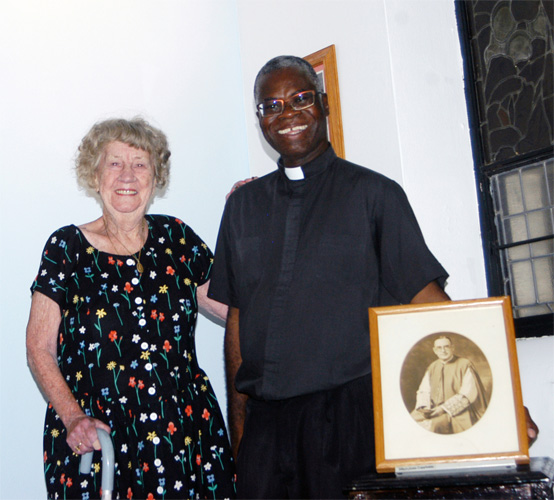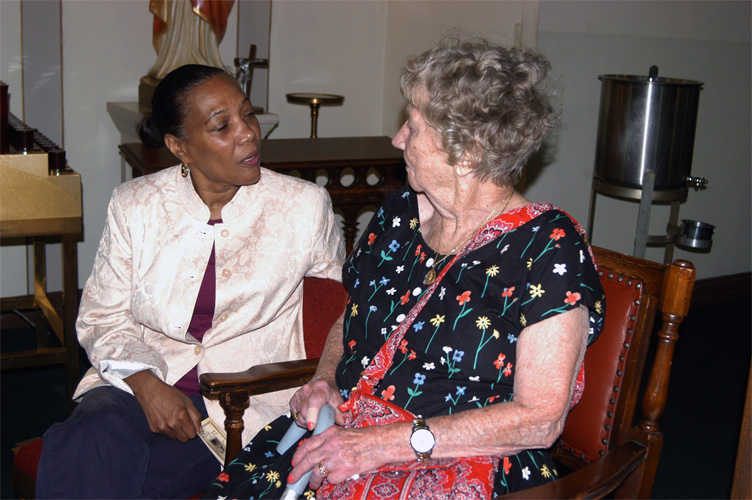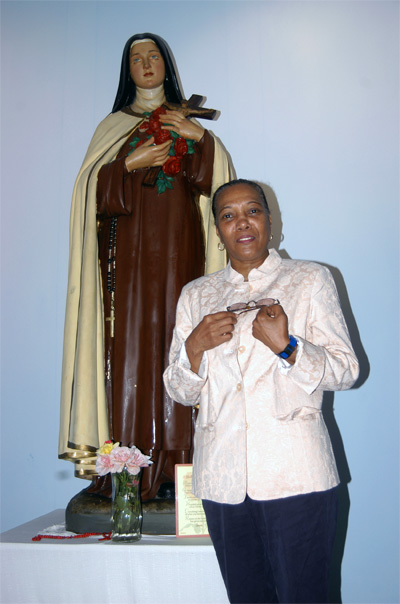
by Marie Elena Giossi
Elizabeth Dwyer marveled at the sight of a statue of St. Therese of Lisieux inside St. Peter Claver Church, Bedford-Stuyvesant, on a recent morning.
More than 80 years had passed since Dwyer, now 93, last stood before the statue as a young girl seeking the Little Flower’s intercession.
“I’m kind of emotional right now,” she said, gazing up at the familiar statue, located in an alcove to the right of the altar. At the statue’s feet were a vase of roses and a pair of eyeglasses.
She returned to see the church again and offer prayers of thanksgiving, both to the saint who restored her vision and the man who introduced her to St. Therese – Servant of God Msgr. Bernard J. Quinn.
Msgr. Paul Jervis is the postulator for Msgr. Quinn’s cause for canonization. He penned the 2005 biography, “Quintessential Priest: The Life of Father Bernard J. Quinn.”
He drove Dwyer from her Bay Ridge home to the church in time for the morning rosary and novena prayers.
“We want to thank the Lord for all the favors and blessings through St. Therese of the Child Jesus and Father Quinn,” Msgr. Jervis said before introducing Dwyer to parishioners.
Speaking to the prayer group, Dwyer said, “As a child, I had a bad eye so my mother took me to Brooklyn Eye and Ear, which was on Greene Avenue, not too far from here.”
Dwyer said that doctors diagnosed her around age 11 with an ulcerated right eye.
“It was very painful,” she said. “I had to wear a bandage or a patch (over the eye) … At that point, it was 1931 or 1932. The doctors didn’t have the medication or the knowledge they have today.”
Uncertain how her vision would fare in the long-term – and tired of the jokes other children would make at her expense – she turned to prayer.

What she heard was no exaggeration. According to the Feb. 23, 1930 edition of The Brooklyn Daily Eagle, the perpetual novena drew nearly 10,000 devotees to the church every Monday.
Dwyer’s older sister Marion worked near the church and had also heard about this novena.
Word of mouth and the elevated train took the sisters four miles each week to the Bedford-Stuyvesant church – the first established specifically for black Catholics in the diocese. The girls joined the masses in praying the novena led by Father Quinn.
“The parishioners were very kind to me,” Dwyer recalled.
Sensed His Goodness
Although she never personally approached Father Quinn, she sensed his goodness. “I knew he was a very gentle soul,” she said.
In time, her eye pain dissipated, and the ulceration healed. Eye doctors “were perplexed with my situation,” she said.
To this day, she credits St. Therese and is grateful to Msgr. Quinn for introducing her to the Little Flower. When she heard about his cause for canonization, she began a spiritual friendship with him.
“I talk to him,” she said. “Prayer is wonderful, but it’s kind of strict. I like to talk person-to-person, and I feel I can with him.”
Dwyer’s story resonated with St. Peter Claver parishioner Sonja Foort, who also credits St. Therese with healing her eyes.
An injury to her right eye and poor vision required Foort to wear glasses starting at age 10. Two years ago, she began experiencing headaches and eye pain.

The day after St. Therese’s feast day in 2012, she was on her way to work when she realized that she could see very clearly. She then had a more startling realization: She had forgotten to put on her glasses that morning.
The pain was gone; her sight was restored; and her prayers were answered.
“I told everybody that had an ear that I could see, that St. Therese interceded for me,” said Foort, whose glasses sit at the foot of the parish statue.
“St. Therese still continues to answer prayers,” Msgr. Jervis told members of the prayer group triumphantly. “Because Father Quinn was so closely associated with her, now he is also in a position to intercede.”
Both Foort and Dwyer are now praying for St. Therese’s intercession with another special intention: Msgr. Quinn’s canonization.
“I certainly hope it’s in my lifetime,” Dwyer said.
